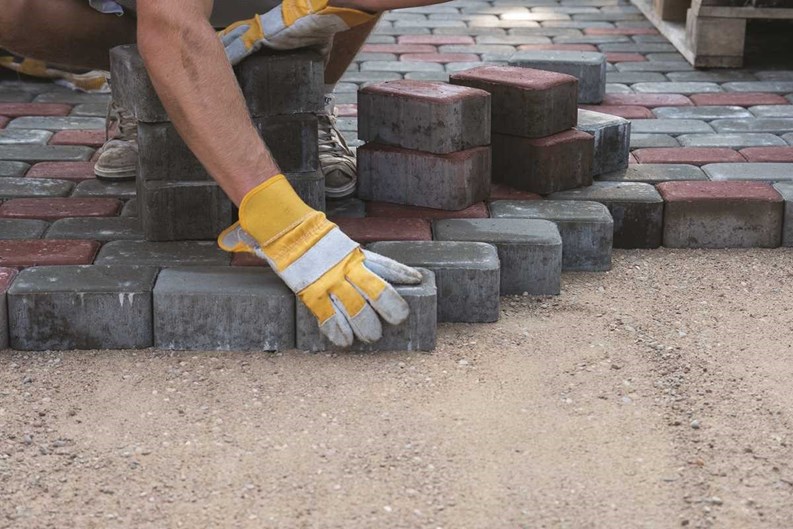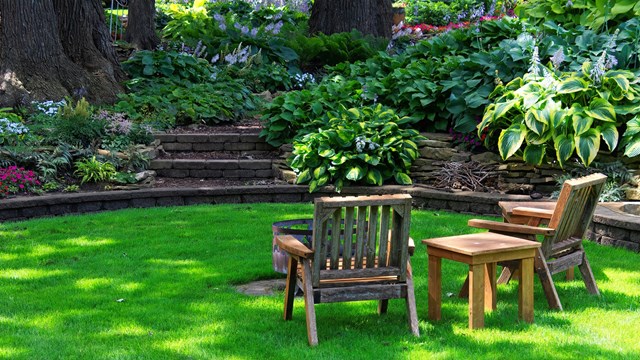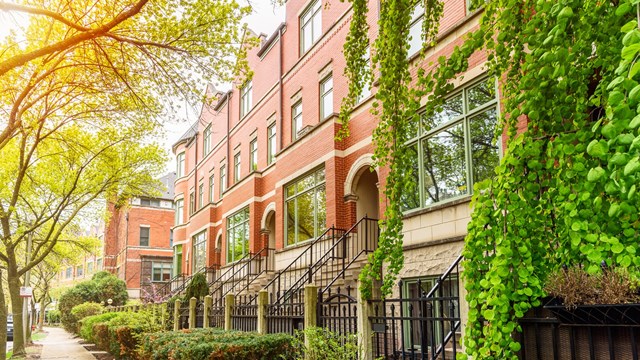When most people think of landscaping, they think of shrubs, trees, meticulously laid-out and maintained flowerbeds, and artful plantings scattered around a building or development.
While that's definitely accurate, landscaping doesn’t end with growing things, however—and if you’ve only got grass in your backyard or patio area, you’re missing out on what could be a beautiful feature and selling point in your home. It’s also an alternative way to make your backyard look great while saving yourself time and money if you’re tired of the maintenance that mowing and seasonal yard work takes.
Hardscaping is a term coined to describe non-plant-related landscaping; things like rock gardens, patios and outdoor kitchens, walking paths, terraces and decorative wall elements. Not only are plant-free landscapes an interesting departure from the more traditional bushes ‘n’ shrubs approach, but rocks and paving stones require far less maintenance than a tree or delicate flowerbed, and may represent an opportunity for eventual cost savings for residential complexes or individual homes.
They also offer a nice way for someone to add something a little different to their backyard if theirs is very large.
Casting the First Stone
Before condos and building complexes just jump right in, however, there is more to a hardscape that meets the eye—as in most things. So we grilled the experts to get the dirt on what you need to do when it comes to hardscapes.
Anything that is on a hard surface outdoors counts as a hardscape—so the name has everything to do with the definition of the term, explains Heath Frey, project direction manager with Hirsch Brick and Stone, a masonry construction company in Park City, Illinois, specializing in custom construction of patios, pool decks, driveways, seat walls and columns.
“Hardscaping is an all-encompassing word for all the hard surfaces out in your lot or property,” Frey says. This ranges from the sidewalks, the pavements, terraces, walls, steps—anything you can think of when it comes to the surface area. “In the past, you used to be able to differentiate the hardscape from the landscape because it was impossible to permeate a hardscape, but now there are pavers that allow water to permeate,” so the definition has evolved with technology, Frey says.
Broadly speaking, there are no special licenses or credentials needed to do hardscaping, though in Illinois, many municipalities do require a license to work in that area—so as with any other contractor, condo administrators need to check with the village or city hall prior to starting the job. Many townhome or condo complexes also have their own regulations regarding how capital improvement projects must be handled, so any drawings will need to be approved by a board before moving onto the next stage. But aside from that, there is no greater authority looking over the work of hardscape contractors.
Since no formal credentials are needed, anyone from veteran landscapers to someone who has no businesses doing hardscaping may offer their services to a condo or HOA community. But hardscaping experts suggest that because of all the things that can potentially complicate a hardscaping project, you should do your due diligence—and they strongly suggest only hiring someone with specific hardscaping experience.
“There are a few that do both [hardscaping and traditional landscaping] says Frey, “but it's really something that should be specialized. When you don’t know exactly what you’re doing, you can make it look nice, but two or three or four years down the road, you see a big difference,” he says.
Issues that may occur include settling, shifting or movement of the hardscaping elements. If there’s concrete involved and it’s not poured deep or wide enough, it can cause an array of problems, from cracking and heaving to drainage issues.
“Thickness of material is very important, where the material comes from—you don’t want to use stones from a region that wouldn’t stand up to the winters here because they would freeze here. They have to have a certain density,” Frey says. The cuts of the material, how straight and square they are, is also important, he says.
Stepping Stones
Once you’ve chosen a hardscape landscaper to do the work, the next step is to figure out a design. “It all starts with a site visit,” says Chris Coe, vice president of construction for Moore Landscapes, Inc. in Northbrook, a full-service landscape and hardscaping contract company.
Most firms employ landscape architects who work with clients to draft an aesthetically-pleasing design before moving on to engineering the actual installation. It can get complicated, depending on what type of hardscape you’re doing. If you’re only putting in a driveway, a walking path, or a hard garden area, the process will likely be fairly straightforward. But once you start to put in a retaining wall, or want a waterfall or anything else on that scale, it gets more complicated.
“You have to know what you’re dealing with, and you have to look at the site to make sure it’ll work, that you have proper drainage so that you’re not flooding a basement,” says Coe. “Once you get above a certain height, you need to contact civil engineers, and make civil drawings to make sure it’s safe and will stand the test of time. There are precautions to make sure everything will work.”
Many people looking to put a simple terrace or patio on their home usually don’t need to go through all of that—but they do still need to check with their municipality to make sure their plan is in compliance with any local requirements, such as what materials are allowed and how large a given structure can be, says Todd Dickey, landscape designer and business development with Wingren Landscape based in Downers Grove.
And size does matter. If your HOA is installing a common patio, you need to think about how many people you plan to entertain on that patio.
“If you were to put in a 5-foot round table, you would need 12-by-12 in terms of space,” Dickey says. “That’s a comfortable space. When I look at patios, I look at how large a table they need, and I build on that. It gives you an idea of what you need. A lot of it has to do with how they are going to use the space.”
Stone Cold Facts
Of course, as with any common area project, the final consideration to be made regarding a hardscaping project is the cost. According to Dickey, hardscaping pricing ranges greatly by the job but is usually priced by the square foot. For terraces in Illinois, the price is typically between $15-$40 per square foot depending on the material.
Natural stone tends to cost the most, while concrete pavers and bricks cost the least. But the price will go up if the access is more difficult. “If it’s a property where it’s difficult to get to the back or to the front, the prices may fluctuate a bit,” Dickey says.
Hardscaping costs significantly more money than landscaping does upfront because the materials cost more. You’re paying for stones, bricks, concrete and other materials that cost more than seeds, plants and dirt cost. The cost to transport those heavy items is also more, which brings the price up as well. And since you’re mostly likely going to be working with someone who is a specialist in this particular field, the price for labor will be higher too.
But don't let that shoo you away from considering hardscaping for your building or association. In addition to looking fabulous, a major selling point for hardscaping elements is that the maintenance on them is significantly less than with traditional landscaping, and over time it can actually save your association money on upkeep and replacement materials.
“It's a little more expensive upfront—or a lot more expensive, if you're doing paving and stonework,” Coe says, “but after that, it shouldn’t be too extreme.”
Brick and stone may need to be cleaned and sealed from time to time, but retaining walls don’t need too much maintenance aside from cleaning once in a while. Stone and brick are certainly a lot less maintenance than weekly lawn mowing, shrubbery cutting and seasonal lawn care. And it always looks clean and tidy—as long as you hired a reputable hardscaper so that your bricks and stones don’t shift and crumble after only a few years.
Indeed, hardscaping only has a few natural enemies. One such foe is the ferocious chipmunk. Yes, you heard that right.
“They will dig underneath and create a burrow, which will cause the pavers and the stone to settle,” Frey says. Chipmunks tend to burrow right where a sidewalk or patio meets the building, because the building foundation is warm—and the Chicago winters are not. “We haven’t figured out how to prevent the chipmunk problem entirely.” Frey says. “We’ve been installing a mesh around, and it’s seeming to help tremendously, but prevent is a strong word.”
Chipmunks notwithstanding however, hardscaping can be an attractive, low-maintenance alternative to traditional landscaping schemes, both for smaller buildings and for larger HOA communities. Nothing may be cast in stone, but with the right professionals and a good design, your property can look rock-solid.
Danielle Braff is a freelance writer and a frequent contributor to The Chicagoland Cooperator.







Leave a Comment